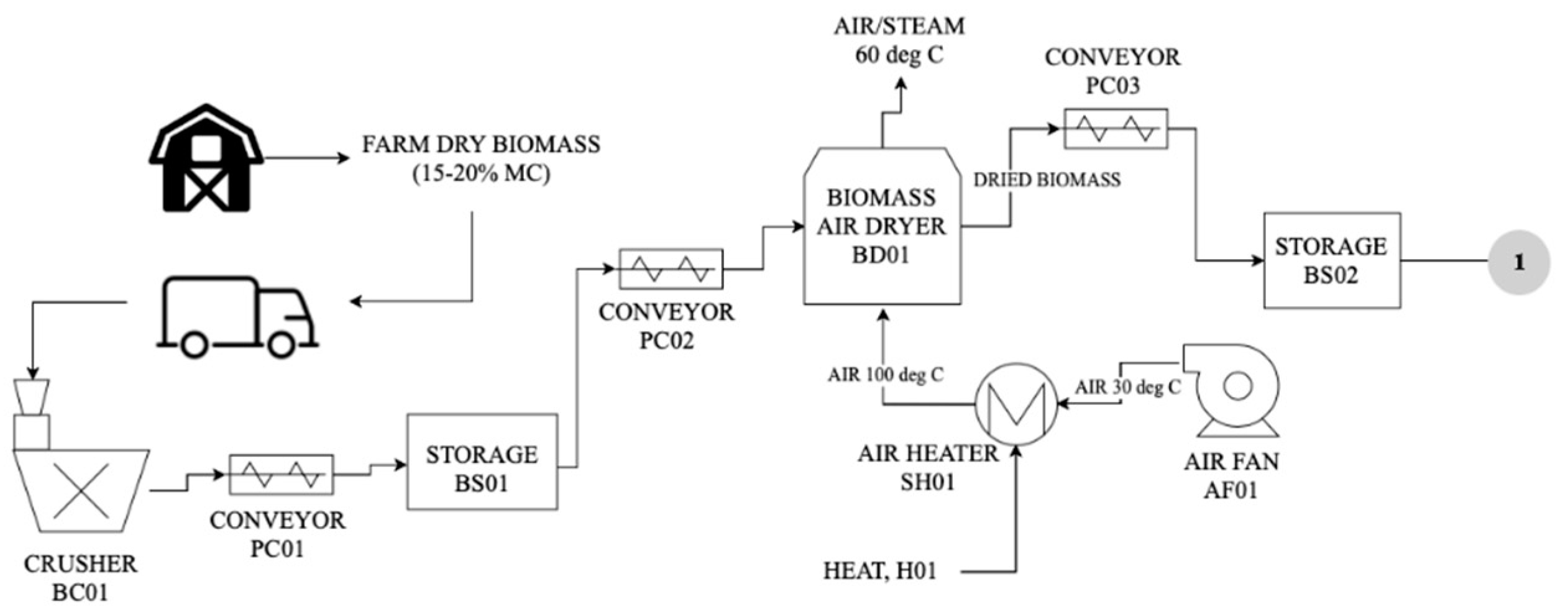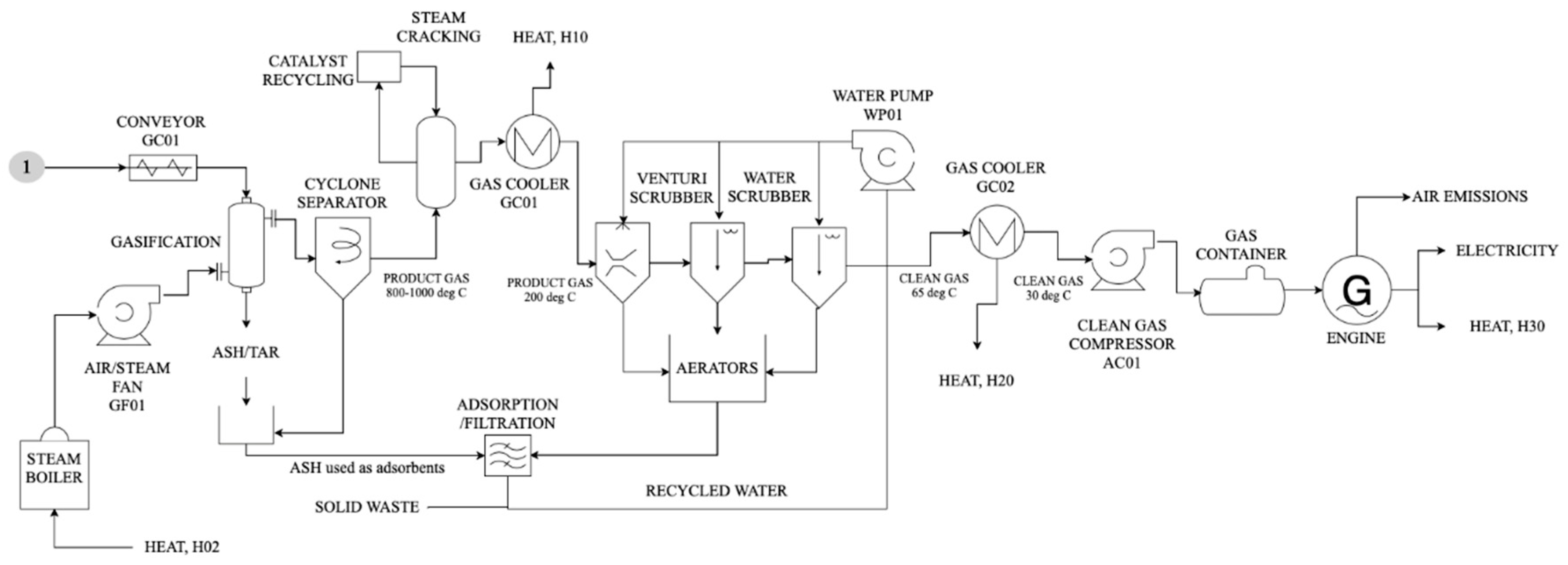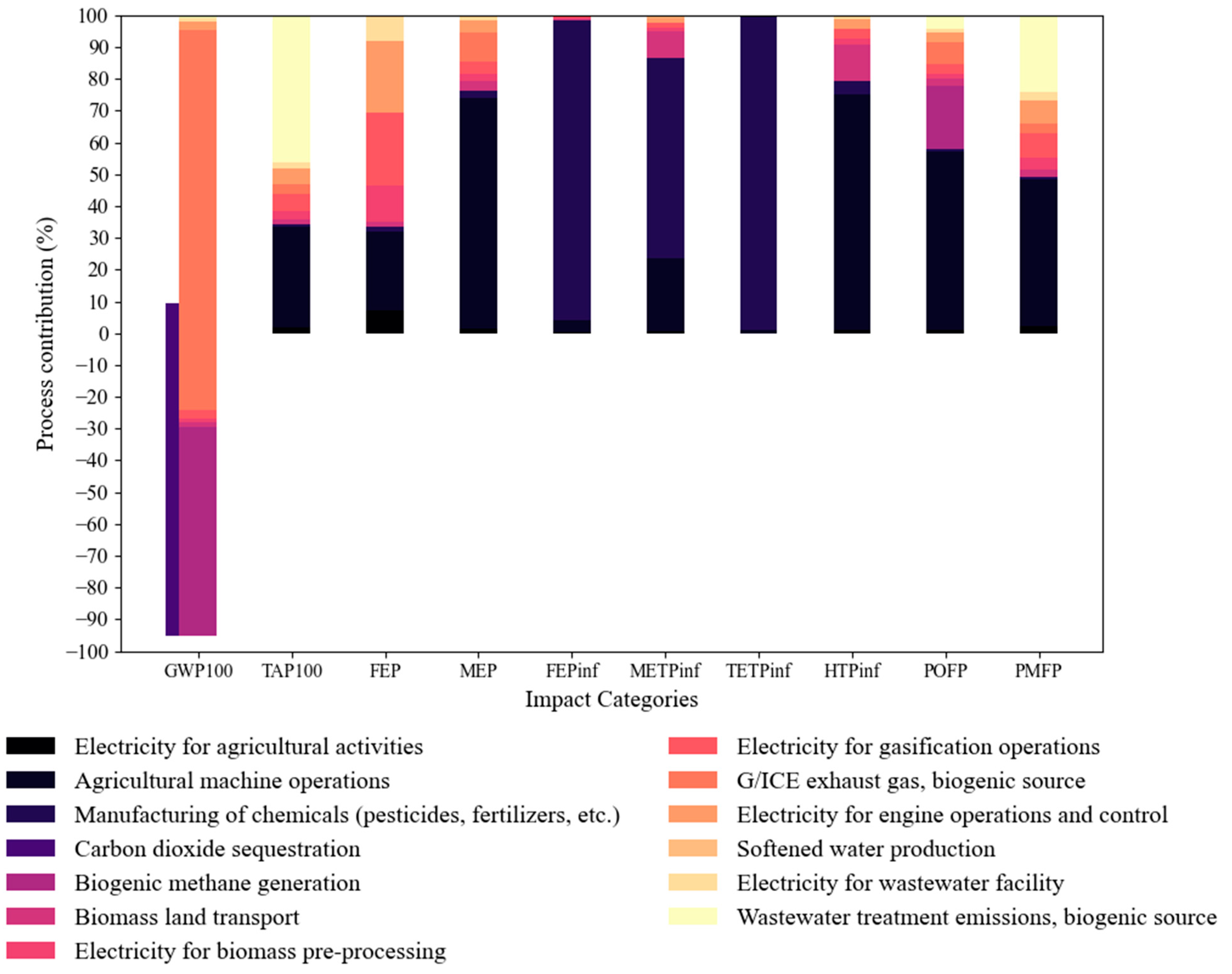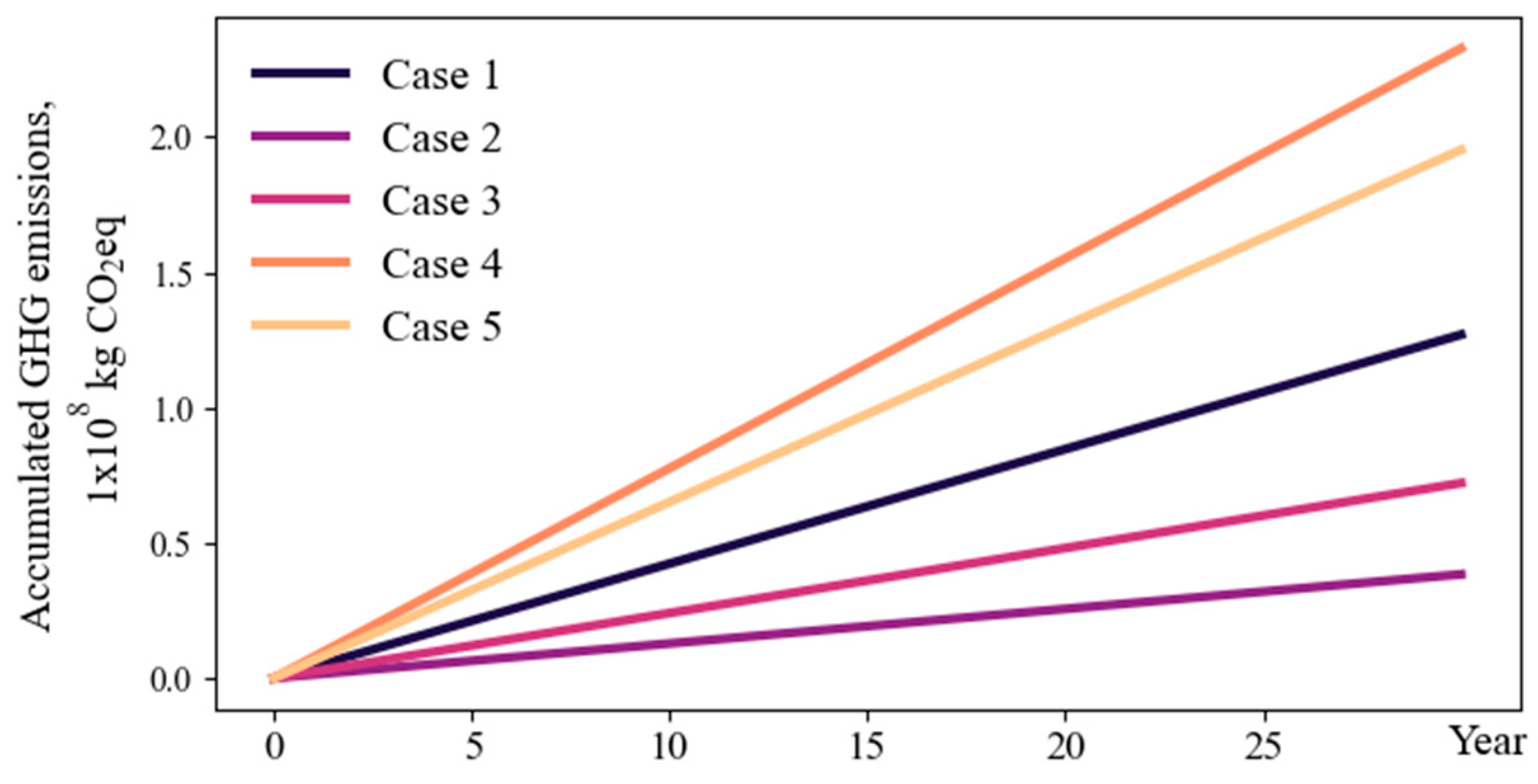Energy Efficiency and Life Cycle Assessment with System Dynamics of Electricity Production from Rice Straw Using a Combined Gasification and Internal Combustion Engine
Abstract
:1. Introduction
2. Materials and Methods
2.1. Life Cycle Assessment–Goal and Scope Definition
2.2. Life Cycle Inventory
2.2.1. Rice Production in the Philippines
2.2.2. Rice Straw Gasification and Producer Gas Internal Combustion Engine
2.3. Life Cycle Impact Assessment
2.4. Energy Efficiency Calculation
2.5. Climate Change and System Dynamics
- Case 1—Electricity from the proposed G/ICE system (default)
- Case 2—Electricity from Philippine power generation mix
- Case 3—Electricity from 100% coal power plant
- Case 4—Burning of rice straw (excluding rice production emissions)
- Case 5—Rice production with rice straw burnt on-site
2.6. Sensitivity Analysis
- Biogenic CH4 emissions to determine the possible impact of farming mitigation procedures;
- CO2 sequestration by the rice plant to determine the rate of carbon uptake necessary to produce a negative net GHG emissions;
- Use of generated electricity from rice straw for rice farming and G/ICE plant operations, thus removing GHG emissions from fossil fuels; and
- Efficiency of the internal combustion engine.
3. Results and Discussion
3.1. LCIA Results and Contributions of Each Processes
3.2. Sensitivity Analysis and Mitigation Measures
3.3. Biomass Energy Utilization and Production Efficiency
4. Conclusions
Supplementary Materials
Author Contributions
Funding
Institutional Review Board Statement
Informed Consent Statement
Data Availability Statement
Conflicts of Interest
References
- Reaño, R.L. Assessment of environmental impact and energy performance of rice husk utilization in various biohydrogen production pathways. Bioresour. Technol. 2020, 299, 122590. [Google Scholar] [CrossRef]
- Gençer, E.; Torkamani, S.; Miller, I.; Wu, T.W.; O’Sullivan, F. Sustainable energy system analysis modeling environment: Analyzing life cycle emissions of the energy transition. Appl. Energy 2020, 277, 115550. [Google Scholar] [CrossRef]
- IEA. Net Zero by 2050; IEA: Paris, France, 2021. [Google Scholar]
- IEA. World Energy Outlook 2020-Summary; Report; IEA: Paris, France, 2020; pp. 1–25. [Google Scholar]
- IEA. Renewables 2019; IEA: Paris, France, 2019. [Google Scholar]
- Briones-Hidrovo, A.; Copa, J.; Tarelho, L.A.C.; Gonçalves, C.; da Costa, T.P.; Dias, A.C. Environmental and energy performance of residual forest biomass for electricity generation: Gasification vs. combustion. J. Clean. Prod. 2021, 289, 125680. [Google Scholar] [CrossRef]
- Beagle, E.; Belmont, E. Comparative life cycle assessment of biomass utilization for electricity generation in the European Union and the United States. Energy Policy 2019, 128, 267–275. [Google Scholar] [CrossRef]
- Filho, F.B.D.; Santiago, Y.C.; Lora, E.E.S.; Palacio, J.C.E.; del Olmo, O.A.A. Evaluation of the maturity level of biomass electricity generation technologies using the technology readiness level criteria. J. Clean. Prod. 2021, 295, 126426. [Google Scholar] [CrossRef]
- Soam, S.; Borjesson, P.; Sharma, P.K.; Gupta, R.P.; Tuli, D.K.; Kumar, R. Life cycle assessment of rice straw utilization practices in India. Bioresour. Technol. 2017, 228, 89–98. [Google Scholar] [CrossRef]
- Reaño, R.L.; Halog, A. Analysis of carbon footprint and energy performance of biohydrogen production through gasification of different waste agricultural biomass from the Philippines. Biomass Convers. Biorefin. 2020. [Google Scholar] [CrossRef]
- Basu, P. Design of Biomass Gasifiers. In Biomass Gasification, Pyrolysis and Torrefaction; Elsevier: Amsterdam, The Netherlands, 2018; pp. 263–329. [Google Scholar]
- Martínez, J.D.; Mahkamov, K.; Andrade, R.V.; Lora, E.E.S. Syngas production in downdraft biomass gasifiers and its application using internal combustion engines. Renew. Energy 2012, 38. [Google Scholar] [CrossRef]
- Raman, P.; Ram, N.K. Performance analysis of an internal combustion engine operated on producer gas, in comparison with the performance of the natural gas and diesel engines. Energy 2013, 63, 317–333. [Google Scholar] [CrossRef]
- Yin, X.L.; Wu, C.Z.; Zheng, S.P.; Chen, Y. Design and operation of a CFB gasification and power generation system for rice husk. Biomass Bioenergy 2002, 23, 181–187. [Google Scholar] [CrossRef]
- Tsiakmakis, S.; Mertzis, D.; Dimaratos, A.; Toumasatos, Z.; Samaras, Z. Experimental study of combustion in a spark ignition engine operating with producer gas from various biomass feedstocks. Fuel 2014, 122, 126–139. [Google Scholar] [CrossRef]
- Collier, Z.A.; Connelly, E.B.; Polmateer, T.L.; Lambert, J.H. Value chain for next-generation biofuels: Resilience and sustainability of the product life cycle. Environ. Syst. Decis. 2017, 37, 22–33. [Google Scholar] [CrossRef]
- Wu, Y.; Su, D. Review of Life Cycle Impact Assessment (LCIA) Methods and Inventory Databases. In Sustainable Product Development; Su, D., Ed.; Springer International Publishing: Cham, Switzerland, 2020; pp. 39–55. [Google Scholar]
- Su, D.; Smith, J.; Wu, Y.; Ren, Z. Environmental Impact Assessment of Farming with Combined Methods of Life Cycle Assessment and Farm Carbon Calculator. In Sustainable Product Development; Su, D., Ed.; Springer International Publishing: Cham, Switzerland, 2020; pp. 249–270. [Google Scholar]
- Delivand, M.K.; Barz, M.; Gheewala, S.H.; Sajjakulnukit, B. Environmental and socio-economic feasibility assessment of rice straw conversion to power and ethanol in Thailand. J. Clean. Prod. 2012, 37, 29–41. [Google Scholar] [CrossRef]
- Cherubini, F.; Ulgiati, S. Crop residues as raw materials for biorefinery systems—A LCA case study. Appl. Energy 2010, 87, 47–57. [Google Scholar] [CrossRef]
- Shafie, S.M.; Masjuki, H.H.; Mahlia, T.M.I. Life cycle assessment of rice straw-based power generation in Malaysia. Energy 2014, 70, 401–410. [Google Scholar] [CrossRef]
- Singh, A.; Basak, P. Economic and environmental evaluation of rice straw processing technologies for energy generation: A case study of Punjab, India. J. Clean. Prod. 2019, 212, 343–352. [Google Scholar] [CrossRef]
- Halog, A.; Manik, Y. Advancing Integrated Systems Modelling Framework for Life Cycle Sustainability Assessment. Sustainability 2011, 3, 469–499. [Google Scholar] [CrossRef] [Green Version]
- Yao, L.; Liu, T.; Chen, X.; Mahdi, M.; Ni, J. An integrated method of life-cycle assessment and system dynamics for waste mobile phone management and recycling in China. J. Clean. Prod. 2018, 187, 852–862. [Google Scholar] [CrossRef]
- McAvoy, S.; Grant, T.; Smith, C.; Bontinck, P. Combining Life Cycle Assessment and System Dynamics to improve impact assessment: A systematic review. J. Clean. Prod. 2021, 128060. [Google Scholar] [CrossRef]
- ISO. ISO 14040: Environmental Management Life Cycle Assessment—Principles and Framework; ISO: Geneva, Switzerland, 2006. [Google Scholar]
- ISO. ISO 14044: Environmental Management Life Cycle Assessment—Requirements and Guidelines; ISO: Geneva, Switzerland, 2006. [Google Scholar]
- Republic of the Philippines Department of Energy. Philippine Energy Plan 2018–2040; Republic of the Philippines Department of Energy: Taguig, Philippines, 2021. [Google Scholar]
- Wernet, G.; Bauer, C.; Steubing, B.; Reinhard, J.; Moreno-Ruiz, E.; Weidema, B. The ecoinvent database version 3 (part I): Overview and methodology. Int. J. Life Cycle Assess. 2016, 21, 1218–1230. [Google Scholar] [CrossRef]
- Philippine Statistics Authority. Crops Statistics of the Philippines; Philippine Statistics Authority: Quezon City, Philippines, 2017; Volume 2015. [Google Scholar]
- Philippine Statistics Authority. Palay Production in the Philippines, 2017–2019; Philippine Statistics Authority: Quezon City, Philippines, 2019. [Google Scholar]
- Cruz, R.D.; Malanon, H.G. On-Farm Mechanization of Paddy in the Philippines. Asian J. Postharvest Mech. 2018, 1, 1–10. [Google Scholar]
- Van Hung, N.; Maguyon-Detras, M.C.; Migo, M.V.; Quilloy, R.; Balingbing, C.; Chivenge, P.; Gummert, M. Rice Straw Overview: Availability, Properties, and Management Practices. In Sustainable Rice Straw Management; Gummert, M., Hung, N., Van Chivenge, P., Douthwaite, B., Eds.; Springer International Publishing: Cham, Switzerland, 2020; pp. 1–13. ISBN 978-3-030-32373-8. [Google Scholar]
- IRRI Water Management—IRRI Rice Knowledge Bank. Available online: http://www.knowledgebank.irri.org/step-by-step-production/growth/water-management (accessed on 24 March 2021).
- Caparino, O.A. Status of Agricultural Waste and Utilization in the Philippines; Philippine Center for Postharvest Development and Mechanization: Nueva Ecija, Philippines, 2018. [Google Scholar]
- Cruz, R.D.; Bobier, S. Farm Power Available for Utilization in Philippine Agriculture. Postharvest Mech. J. 2016, 2, 16p. [Google Scholar]
- Calcante, A.; Oberti, R. A Technical-Economic Comparison between Conventional Tillage and Conservative Techniques in Paddy-Rice Production Practice in Northern Italy. Agronomy 2019, 9, 886. [Google Scholar] [CrossRef] [Green Version]
- Rupesh, S.; Muraleedharan, C.; Arun, P. A comparative study on gaseous fuel generation capability of biomass materials by thermo-chemical gasification using stoichiometric quasi-steady-state model. Int. J. Energy Environ. Eng. 2015, 6, 375–384. [Google Scholar] [CrossRef] [Green Version]
- Dassey, A.; Mukherjee, B.; Sheffield, R.; Theegala, C. Catalytic cracking of tars from biomass gasification. Biomass Convers. Biorefin. 2013, 3, 69–77. [Google Scholar] [CrossRef]
- Park, H.J.; Park, S.H.; Sohn, J.M.; Park, J.; Jeon, J.-K.; Kim, S.-S.; Park, Y.-K. Steam reforming of biomass gasification tar using benzene as a model compound over various Ni supported metal oxide catalysts. Bioresour. Technol. 2010, 101, S101–S103. [Google Scholar] [CrossRef]
- Ishii, K.; Furuichi, T. Influence of moisture content, particle size and forming temperature on productivity and quality of rice straw pellets. Waste Manag. 2014, 34, 2621–2626. [Google Scholar] [CrossRef] [PubMed]
- Migo-Sumagang, M.V.P.; Van Hung, N.; Detras, M.C.M.; Alfafara, C.G.; Borines, M.G.; Capunitan, J.A.; Gummert, M. Optimization of a downdraft furnace for rice straw-based heat generation. Renew. Energy 2020, 148, 953–963. [Google Scholar] [CrossRef]
- Safarian, S.; Richter, C.; Unnthorsson, R. Waste Biomass Gasification Simulation Using Aspen Plus: Performance Evaluation of Wood Chips, Sawdust and Mixed Paper Wastes. J. Power Energy Eng. 2019, 7, 12–30. [Google Scholar] [CrossRef] [Green Version]
- Anis, S.; Zainal, Z.A. Tar reduction in biomass producer gas via mechanical, catalytic and thermal methods: A review. Renew. Sustain. Energy Rev. 2011, 15, 2355–2377. [Google Scholar] [CrossRef]
- Konti, A.; Kekos, D.; Mamma, D. Life Cycle Analysis of the Bioethanol Production from Food Waste—A Review. Energies 2020, 13, 5206. [Google Scholar] [CrossRef]
- Hauschild, M.Z.; Huijbregts, M.A.J. Introducing Life Cycle Impact Assessment. In Life Cycle Impact Assessment; Springer: Berlin, Germany, 2015; pp. 1–16. [Google Scholar]
- Levasseur, A. Climate Change. In Life Cycle Impact Assessment; Springer: Berlin, Germany, 2015; pp. 39–50. [Google Scholar]
- Fortmann-Roe, S. Insight Maker: A general-purpose tool for web-based modeling & simulation. Simul. Model. Pract. Theory 2014, 47, 28–45. [Google Scholar] [CrossRef] [Green Version]
- Nguyen, V.H.; Sander, B.O.; Quilty, J.; Balingbing, C.; Castalone, A.G.; Romasanta, R.; Alberto, M.C.R.; Sandro, J.M.; Jamieson, C.; Gummert, M. An assessment of irrigated rice production energy efficiency and environmental footprint with in-field and off-field rice straw management practices. Sci. Rep. 2019, 9, 16887. [Google Scholar] [CrossRef] [PubMed]
- Chen, S.; Feng, H.; Zheng, J.; Ye, J.; Song, Y.; Yang, H.; Zhou, M. Life Cycle Assessment and Economic Analysis of Biomass Energy Technology in China: A Brief Review. Processes 2020, 8, 1112. [Google Scholar] [CrossRef]
- van Zelm, R.; Roy, P.-O.; Hauschild, M.Z.; Huijbregts, M.A.J. Acidification. In Life Cycle Impact Assessment; Springer: Berlin, Germany, 2015; pp. 163–176. [Google Scholar]
- Aktar, W.; Sengupta, D.; Chowdhury, A. Impact of pesticides use in agriculture: Their benefits and hazards. Interdiscip. Toxicol. 2009, 2. [Google Scholar] [CrossRef] [Green Version]
- Duan, H.; Jia, X.; Zhai, Q.; Ma, L.; Wang, S.; Huang, C.; Wang, H.; Niu, Y.; Li, X.; Dai, Y.; et al. Long-term exposure to diesel engine exhaust induces primary DNA damage: A population-based study. Occup. Environ. Med. 2016, 73, 83–90. [Google Scholar] [CrossRef]
- Jolliet, O.; Fantke, P. Human Toxicity. In Life Cycle Impact Assessment; Springer: Berlin, Germany, 2015; pp. 75–96. [Google Scholar]
- Allen, J.; Pascual, K.S.; Romasanta, R.R.; Van Trinh, M.; Van Thach, T.; Van Hung, N.; Sander, B.O.; Chivenge, P. Rice Straw Management Effects on Greenhouse Gas Emissions and Mitigation Options. In Sustainable Rice Straw Management; Springer International Publishing: Cham, Switzerland, 2020; pp. 145–159. [Google Scholar]
- Hu, Z.; Wu, S.; Ji, C.; Zou, J.; Zhou, Q.; Liu, S. A comparison of methane emissions following rice paddies conversion to crab-fish farming wetlands in southeast China. Environ. Sci. Pollut. Res. 2016, 23, 1505–1515. [Google Scholar] [CrossRef] [PubMed]







| Material Flow | Annual Average | Unit, per ha of Land |
|---|---|---|
| Input | ||
| Inorganic fertilizer [31] | 277.50 | kg |
| Urea | 123.83 | kg |
| Ammonium sulfate | 24.33 | kg |
| Ammonium phosphate | 30.33 | kg |
| Complete | 99.17 | kg |
| Others (solid) | 2.74 | kg |
| Others (liquid) | 0.18 | L |
| Organic (solid) | 6.95 | kg |
| Organic (liquid) | 0.42 | L |
| Pesticide [31] | ||
| Insecticide (solid) | 0.30 | kg |
| Insecticide (liquid) | 0.91 | L |
| Herbicide (solid) | 0.12 | kg |
| Herbicide (liquid) | 0.89 | L |
| Fungicide (solid) | 0.07 | kg |
| Fungicide (liquid) | 0.06 | L |
| Rodenticide (solid) | 0.03 | kg |
| Rodenticide (liquid) | 0.01 | L |
| Molluscicide (solid) | 0.27 | kg |
| Molluscicide (liquid) | 0.15 | L |
| Nematicide (solid) | 0.01 | kg |
| Nematicide (liquid) | 0.01 | L |
| Others (solid) | 0.01 | kg |
| Others (liquid) | 0.03 | L |
| Seed | 39.17 | kg |
| Water (irrigated rice) [34] | 4374.50 | m3 |
| Products | ||
| Milled rice | 2.35 | t |
| Paddy rice | 3.70 | t |
| Rice husk [35] | 0.89 | t |
| Rice straw [33] | 2.70–8.00 | t |
| Machinery Used [36] | Operations | Average Motor Size (hp) | Operation, h/ha [37] | kWh/y | Type |
|---|---|---|---|---|---|
| hand tractor (engine) | Plowing, Harrowing, | 9.4 | 0.59 | 20,846.52 | diesel |
| Transplanter | Transplanting | 6.6 | 0.59 | 14,469.58 | diesel |
| irrigation pump | Irrigation | 1 | 1.07 | 3977.07 | diesel |
| 4-wheel tractor | Plowing, Harrowing, | 76 | 1.39 | 393,274.75 | diesel |
| Combine | Harvesting, threshing | 61 | 0.83 | 188,925.83 | diesel |
| Rice Mill | Milling | 6.2 | 45,254.02 | electricity | |
| Others | lighting, transport | 1 | 1431.75 | electricity | |
| Summary | |||||
| Total diesel energy, MJ/y | 2,237,377.54 | ||||
| Total electricity from grid, MJ/y | 168,068.75 | ||||
| Parameters Used in Design/Calculation | Values | Basis/Remarks |
|---|---|---|
| Days of operation per year | 300 | |
| Gasification operation hours per day | 12 | |
| PRE-PROCESSING | ||
| Rice straw feed rate, kg/h | 1875.00 | About 0.02–0.06% of total available rice straw per year |
| Initial moisture content | 20% | 8–25% initial moisture content of rice straw [41] |
| Biomass crushing | ||
| Particle size | <5 cm | <5 cm [12] |
| Drying | ||
| Moisture content, % | 5.42% | <25% [12] |
| GASIFICATION | ||
| Rice straw feed rate, kg/h | 1500.00 | [42] |
| Rice straw LHV, MJ/kg | 14.72 | |
| Ultimate analysis: C, H, O, N, S, Ash (% weight) | 35.5, 4.62, 58.83, 0.99, 0.06, 19.86 | |
| Parameters | ||
| Gasification temperature, °C | 1000 | 800–1200, average is 1000 [10,12] |
| Equivalence ratio (ER) | 0.2 | 0.20–0.30 [43]; 0.20–0.40 [12] |
| Steam to biomass ratio (SBR) | 0.25 | |
| Air supplied, kg/h | 831.23 | Calculated based on ER |
| Steam flowrate (1 bar, 300 °C), kg/h | 375 | Calculated based on SBR |
| Output | ||
| Syngas composition, H2, CO, CO2, CH4, N2 | 13%, 26%, 22%, 2%, 37% | Equation (1),Calculated is based on the methodology presented in the following studies: [10,38]. |
| Steam, Nm3/h | 1046.6 | |
| Elemental C, kg/h | 88.674 | |
| Tar, kg/h | 22.582 | |
| Ash, kg/h | 297.90 | |
| H2S, kg/h | 0.93490 | |
| Summary | ||
| Gas yield, Nm3/kg rice straw | 0.920 | |
| LHV, MJ/Nm3 | 5.26 | Equation (4) |
| Gasification efficiency | 33.0% | |
| GAS CLEANING AND PURIFICATION | ||
| Inertial separators | ||
| Percent efficiency | 50 | [14] |
| Cyclone separators | ||
| Percent efficiency | 90 | [14] |
| Unreacted Carbon recovered, kg/h | 84.24 | |
| Ash recovered, kg/h | 283.01 | |
| Tar cracking, 700 °C | ||
| Tar from syngas, kg/h | 22.582 | Tar is represented by C6H6. |
| Steam, kg/h | 841.77 | |
| Percent conversion efficiency | 87.2 | [44] |
| Tar Cracking products | ||
| H2, kg/h | 4.57 | Equation (3) |
| CO, kg/h | 42.4 | |
| Venturi scrubber | ||
| Percent efficiency | 90% | [14] |
| Water scrubber (2 units) | ||
| Percent efficiency | 95% | [14] |
| Fuel gas, million Nm3/y | 5.256 | producer gas + cracked tar |
| LHV fuel gas, MJ/Nm3 | 5.62 | Equation (4) |
| Tar in gas, mg/Nm3 | 0.49 | 10–100 mg/Nm3 gas allowable [12] |
| Total gas impurities (C, Ash, H2S, tar, water), ppm | 0.14 | |
| Fuel gas composition: H2, CO, CO2, CH4, N2 (% by volume) | 15.9, 27.0, 20.4, 1.67, 35.1 | |
| Internal combustion engine | ||
| Fuel flowrate, m3/h | 730.05 | based on gasification fuel gas production |
| Air flowrate (20% excess), m3/h | 1899 | |
| Actual Air/Fuel (A/F) ratio, by volume | 2.6 | |
| Power generation efficiency | 22% | 20–22% efficiency for producer gas engine, [13] |
| Electricity output, TJ/y | 6.5 | Equivalent to 155.13 toe |
| Fuel gas consumption, Nm3/MJ (Nm3/kWh) | 0.81 (2.91) | In comparison to rice husk: 3.76 Nm3/kWh [14] |
| Flue gas | ||
| Composition: N2, CO2, H2O, O2, CO, NO2 (% by weight) | 70.3, 23.3, 3.74, 2.65, 0.0125, 0.00332 | |
| Temperature, °C | 500 | |
| Water treatment | ||
| Influent, kg/h | 8000 | |
| COD, ppm | 1156.73 | |
| Water, for recycling, kg/h | 8000 | |
| COD, ppm (effluent) | 0.1 | [14] |
| Filtered solids, kg/h | 19.32 | based on material balance |
| Air emissions | ||
| CO2, kg/h | 4.88 | based on material balance |
| SO2, kg/h | 0.878 |
| Equipment | No. of Units | Code | Capacity | Power Rating, kW |
|---|---|---|---|---|
| Pre-processing | ||||
| Ball crusher | 1 | BC01 | 3000 kg/h | 30 |
| Conveyor | 2 | PC01, PC02 | 2400 kg/h | 0.6 |
| Boiler/Steam heater | BD01 | Recycled heat | ||
| Air fan/dryer | 2 | AF01 | 40,000 m3/h | 15 |
| Gasification | ||||
| Air/steam fan | 1 | GF01 | 5000 m3/h | 15 |
| Ash conveyor | 1 | 1 | ||
| Gasifier | 1500 kg/h | |||
| Gas Pump | 1 | CF01 | 15 | |
| Water pump, 4.3 bar (g) | 1 | WP01 | 8000 kg/h | 7.5 |
| Cooling water pump | 1 | 60 m3/h | 7.5 | |
| Cooling water air fan | 1 | 11 | ||
| Aerators | 7.5 | |||
| Internal combustion engine | ||||
| Gas compressor, 10 kPa | 1 | AC01 | 8000 m3/h | 37 |
| Control power transformer | 1 | 4.5 |
| Impact Categories | Unit per MJ Electricity | Values |
|---|---|---|
| climate change | kg CO2-eq | 0.642 |
| terrestrial acidification | kg SO2-eq | 0.00208 |
| freshwater eutrophication | kg P-eq | 6.69 × 10−6 |
| marine eutrophication | kg N-eq | 4.73 × 10−5 |
| freshwater ecotoxicity | kg 1,4-DCB-eq | 0.00138 |
| marine ecotoxicity | kg 1,4-DB-eq | 2.78 × 10−4 |
| terrestrial ecotoxicity | kg 1,4-DCB-eq | 0.00171 |
| human toxicity | kg 1,4-DCB-eq | 0.0121 |
| photochemical oxidant formation | kg NMVOC-eq | 0.00180 |
| Case | BER | NER |
|---|---|---|
| ICE efficiency = 22% (default) | 0.065 | 1.64 |
| ICE efficiency = 35% | 0.10 | 2.61 |
| ICE efficiency = 50% | 0.15 | 3.73 |
| G/ICE plant provides electricity for rice farming operations | 0.041 | 1.03 |
| G/ICE plant provides electricity for self-operations | 0.050 | 1.25 |
| G/ICE plant provides all electricity demand of the system | 0.026 | 0.64 |
Publisher’s Note: MDPI stays neutral with regard to jurisdictional claims in published maps and institutional affiliations. |
© 2021 by the authors. Licensee MDPI, Basel, Switzerland. This article is an open access article distributed under the terms and conditions of the Creative Commons Attribution (CC BY) license (https://creativecommons.org/licenses/by/4.0/).
Share and Cite
Reaño, R.L.; de Padua, V.A.N.; Halog, A.B. Energy Efficiency and Life Cycle Assessment with System Dynamics of Electricity Production from Rice Straw Using a Combined Gasification and Internal Combustion Engine. Energies 2021, 14, 4942. https://doi.org/10.3390/en14164942
Reaño RL, de Padua VAN, Halog AB. Energy Efficiency and Life Cycle Assessment with System Dynamics of Electricity Production from Rice Straw Using a Combined Gasification and Internal Combustion Engine. Energies. 2021; 14(16):4942. https://doi.org/10.3390/en14164942
Chicago/Turabian StyleReaño, Resmond L., Victor Antonio N. de Padua, and Anthony B. Halog. 2021. "Energy Efficiency and Life Cycle Assessment with System Dynamics of Electricity Production from Rice Straw Using a Combined Gasification and Internal Combustion Engine" Energies 14, no. 16: 4942. https://doi.org/10.3390/en14164942
APA StyleReaño, R. L., de Padua, V. A. N., & Halog, A. B. (2021). Energy Efficiency and Life Cycle Assessment with System Dynamics of Electricity Production from Rice Straw Using a Combined Gasification and Internal Combustion Engine. Energies, 14(16), 4942. https://doi.org/10.3390/en14164942






